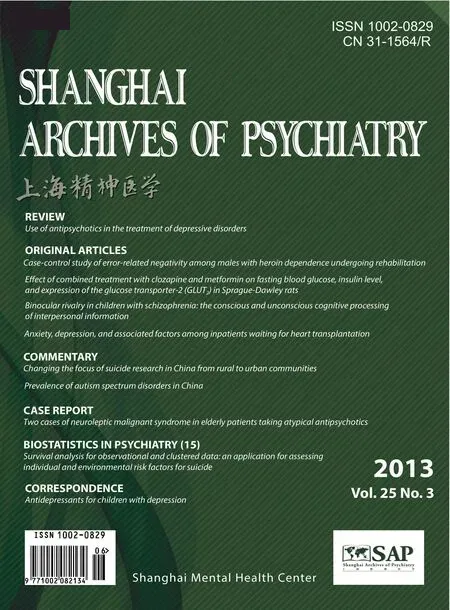Antidepressants for children with depression
Sirichai HONGSANGUANSRI
· Correspondence·
Antidepressants for children with depression
Sirichai HONGSANGUANSRI
The Forum about treating depressed children presented in the previous issue of the journal[1,2]highlighted several important issues about this controversial topic. Depression in children is a devastating disorder that effects psychosocial development and has long-term negative outcomes for both the patients and their families.[3-5]It has a relatively high prevalence of 1 to 2% in children and 3 to 8% in adolescents[3], but there are few randomized controlled trials on the efficacy of pharmacotherapy and other treatments for the disorder.[3-9]
After the FDA’s ‘black box’ warning about the potential suicide risk of antidepressant use in children in 2004,the diagnosis of pediatric depression in the United States decreased from 5 per 1000 managed care enrollees to 3 per 1000 and the prescription of antidepressants among treatment-naive patients with depression who were 5 to 21 years of age decreased by approximately 50%.[6]These changes following the FDA warning suggest that many children with depression were not being treated with appropriate medication. This hypothesis is supported by the increase in the suicide rates of children and adolescents - by 14% in the United States[10]and 25%in Canada[6]-in the years following the FDA warning compared to increasing antidepressant prescription use and a decline in suicide rates among children and youth in the years prior to the warning.[6,7]
The results of several reviews about the association between the treatment of pediatric depression with antidepressants and suicidality have questioned the appropriateness of the FDA warning.[5-11]Ecological studies have reported a beneficial effect of antidepressant prescription in children and adolescents. In the United States, suicide rates among children and adolescents decreased from 4.4 per 100,000 to 2.8 per 100,000 between 1999 and 2003, a period during which there was a substantial increase in the rates of prescription of selective serotonin reuptake inhibitor (SSRI) antidepressants for pediatric depression.[6]The Treatment for Adolescents with Depression Study (TADS) found that adolescents with major depressive disorder (MDD) show significant decreases in suicidality in all treatment arms but no significant difference in between those treated with fluoxetine and those treated with CBT.[12]More recent studies also indicate that antidepressants are modestly effective for the treatment of pediatric MDD and that the benefits outweigh the risks of suicidalilty.[11]Finally,the FDA’s warning applied to all antidepressants, but it appears that the relationship between antidepressant use and suicidality in children and adolescents varies for the different types of antidepressants.[4]
Despite the limited number of randomized controlled trials of pharmacotherapy for children with depressive disorders and the inconsistency of the results,[5]several studies found that SSRIs were significantly superior to placebo.[5,6,9-11]But some studies report anti-depressants of limited use in children with depression.[9]Psychotherapy, especially CBT, and manipulation of the psychosocial context (including treatment of parental psychopathology) is considered effective for most children with mild or moderate depression,[7,10]but usually needs to be augmented with antidepressants in those with severe depression.[9]Based on scientific reviews and expert consensus statements, several practice guidelines recommend using fluoxetine or escitalopram - both of which are approved by the FDA - as the first-line pharmacological treatment for children and adolescents with MDD if medication is indicated.[5-11]With appropriate monitoring for suicidality and other potential adverse events, patients with severe forms of pediatric MDD or with less severe MDD that does not respond to psychosocial interventions alone will often benefit from combined psychosocial and psychopharmacological interventions.
1. Du YS. Should antidepressants be used to treat childhood depression? Shanghai Archives of Psychiatry 2013; 25(1):48-49.
2. Craighead WE. Interventions for childhood depression.Shanghai Archives of Psychiatry 2013; 25(1): 50-51.
3. Wagner KD, Emslie GJ, Kowatch RA, Weller EB. An update on depression in children and adolescents. J Clin Psychiatry 2008; 69: 1818-1828.
4. Brent DA, Maalouf FT. Pediatric depression: is there evidence to improve evidence-based treatments? J Child Psychol Psychiatry 2009; 50: 143-152.
5. Gentile S. Antidepressant use in children and adolescents diagnosed with major depressive disorder: what can we learn from published data? Rev Recent Clin Trials 2010; 5:63-75.
6. Adegbite-Adeniyi C, Gron B, Rowles BM, Demeter CA, Findling RL. An update on antidepressant use and suicidality in pediatric depression. Expert Opin Pharmacother 2012; 13:2119-2130.
7. Maalouf FT, Brent DA. Pharmacotherapy and psychotherapy of pediatric depression. Expert Opin Pharmacother 2010;11: 2129-2140.
8. Smiga SM, Elliott GR. Psychopharmacology of depression in children and adolescents. Pediatr Clin North Am 2011; 58:155-171.
9. Taurines R, Gerlach M, Warnke A, Thome J, Wewetzer C.Pharmacotherapy in depressed children and adolescents.World J Biol Psychiatry 2011; 12 (suppl 1): 11-15.
10. Hughes CW, Emslie GJ, Crismon ML, Posner K, Birmaher B,Ryan N, et al. Texas Children’s Medication Algorithm Project:update from Texas Consensus Conference Panel on Medication Treatment of Childhood Major Depressive Disorder. J Am Acad Child Adolesc Psychiatry 2007; 46: 667-686.
11. Bailly D. Benefits and risks of using antidepressants in children and adolescents. Expert Opin Drug Saf 2008; 7: 9-27.
12. March J, Silva S, Petrycki S, Curry J, Wells K, Fairbank J, et al. Fluoxetine, cognitive-behavioral therapy, and their combination for adolescents with depression: Treatment for Adolescents With Depression Study (TADS) randomized controlled trial. JAMA 2004; 292: 807-820.
10.3969/j.issn.1002-0829.2013.03.011
Division of Child and Adolescent Psychiatry, Department of Psychiatry, Faculty of Medicine, Ramathibodi Hospital, Mahidol University, Bangkok, Thailand
correspodence: sirichai_hong@yahoo.com

Sirichai Hongsanguansri graduated from the Faculty of Medicine, Ramathibodi Hospital, Mahidol University in 1989 and was certified by the Thai Board of Pediatrics in 1995 and Thai Board of Child and Adolescent Psychiatry in 1998. He is currently an Associate Professor and Deputy Head of the Department of Psychiatry in the Faculty of Medicine at Ramathibodi Hospital, Mahidol University. He is also a committee member of the Psychiatric Association of Thailand and of the Child and Adolescent Society of Thailand. His research interests include ADHD, computer game and Internet addiction, adolescent mental health and depression in children and adolescents.
- 上海精神醫學的其它文章
- Should repeve Transcranial Magnec Smulaon (rTMS)be considered an effecve adjuncve treatment for auditory hallucinaons in paents with schizophrenia?
- Survival analysis for observational and clustered data: an application for assessing individual and environmental risk factors for suicide
- Prevalence of ausm spectrum disorders in China
- Changing the focus of suicide research in China from rural to urban communities
- Two cases of neuroleptic malignant syndrome in elderly patients taking atypical antipsychotics
- Anxiety, depression, and associated factors among inpatients waiting for heart transplantation

